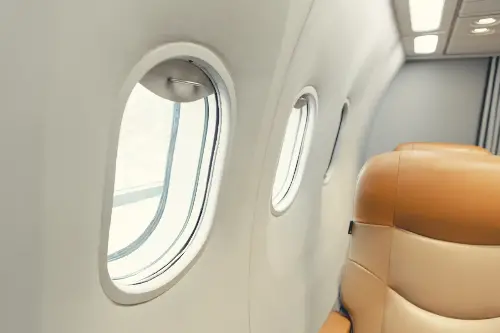Have you ever settled into your seat on an aircraft and looked out of the window, only to pause and wonder why those windows are round instead of square? While you might initially think it's merely a design choice, the roundness of airplane windows is actually a critical feature related to the safety and structural integrity of the aircraft. Let's take flight into this high-flying mystery and uncover the secrets behind the circular design.

The Perils of Square Windows: A Lesson from History
To understand the reason behind the round windows, we must first take a trip back in history. In the early days of aviation, airplanes had square windows, which seemed practical and aesthetically pleasing. However, this seemingly innocuous choice had dire consequences. The de Havilland Comet, the world’s first commercial jetliner, suffered from catastrophic accidents in the 1950s, with two Comets breaking apart in mid-air. The reason? Square windows.
Crash investigations revealed something stunning – the corners of the square windows were experiencing stress concentration, a phenomenon where stress is greater at sharp edges compared to smooth surfaces. Every time the aircraft pressurised and depressurised during flights, these weak points underwent intense stress, leading to metal fatigue and ultimately, structural failure. This discovery revolutionised aviation design principles.
Stress and Strain: The Physics of Flying
At cruising altitude, an airplane's cabin is pressurised to a level where humans can breathe comfortably. However, this creates a significant difference between the pressure inside the cabin and the thin air outside. Imagine blowing up a balloon: the rubber stretches and becomes thinner at some places than at others. In an aircraft, the fuselage is doing the heavy lifting to keep the high pressure inside from bursting out, much like the skin of the balloon.
Square windows, with their sharp corners, proved to be weak spots where the stress was magnified. To combat this, engineers turned to shapes that allowed the pressures to distribute more evenly. And thus, the era of round windows took flight. A circle has no beginning or end, no sharp points to serve as stress concentrators, ensuring that pressure is distributed evenly around the window's perimeter.
The Ingenuity of the Rounded Edge
Following the Comet incidents, the aviation world settled on a new standard: round or oval windows. But it wasn't just the shape that changed; the approach to managing pressure and reducing stress also improved. Windows were redesigned with rounded edges, allowing stress to flow smoothly around the window, rather than accumulating at points of weakness.
This change in shape makes the difference between staying intact or developing dangerous cracks. Over time, these rounded windows have undergone further refinements: they are now double-paned and often have a tiny hole in the middle, known as a bleed hole, to balance pressure differences.

Aerodynamics and Efficiency: The Circle's Hidden Benefits
Aside from the safety implications, round windows also offer benefits in aerodynamics and aircraft efficiency. Square windows could potentially create drag, which reduces an aircraft’s efficiency. Circular windows, on the other hand, help in maintaining the smooth flow of air across the fuselage.
Furthermore, the process of pressurisation and depressurisation is much more efficient with round windows. An even distribution of stress means the aircraft structure is less prone to fatigue and can withstand the rigours of high-altitude flying with greater resilience, leading to a longer service life.
Embracing the View: Passenger Comfort and Aesthetics
Despite their origins in safety and structural integrity, round windows have also shaped the passenger experience. The windows in modern airliners provide ample opportunity for passengers to gaze out at the world from above. The view from 35,000 feet is framed perfectly by these portholes in the sky, creating a sense of wonder and excitement.
In terms of aesthetics, the round windows have been seamlessly integrated into aircraft design, contributing to the sense of modernity and technological prowess that airliners project. While we might have grown accustomed to these round windows, they still carry an inherent futuristic appeal, reminiscent of spacecraft portholes, melding form with function in elegant harmony.

Final Descent: Why Safety Always Comes First
As we touch down on this topic, it's clear that the round airplane windows are more than just a design choice; they're a lifesaver. This critical feature is a perfect example of how the history, science, and even tragedies of aviation have contributed to the safer skies we enjoy today. Air travel is safer because of the careful attention to details like these, and every time you peer out of that rounded window, remember that you are looking through a portal designed by the hard-earned lessons of the past century.
So, the next time you board a plane, take a moment to appreciate the clever engineering that goes into every aspect of your journey, right down to the round windows that have become a hallmark of safe and efficient flight design. It's a small detail with a huge impact, ensuring that you can soar through the skies with confidence.
